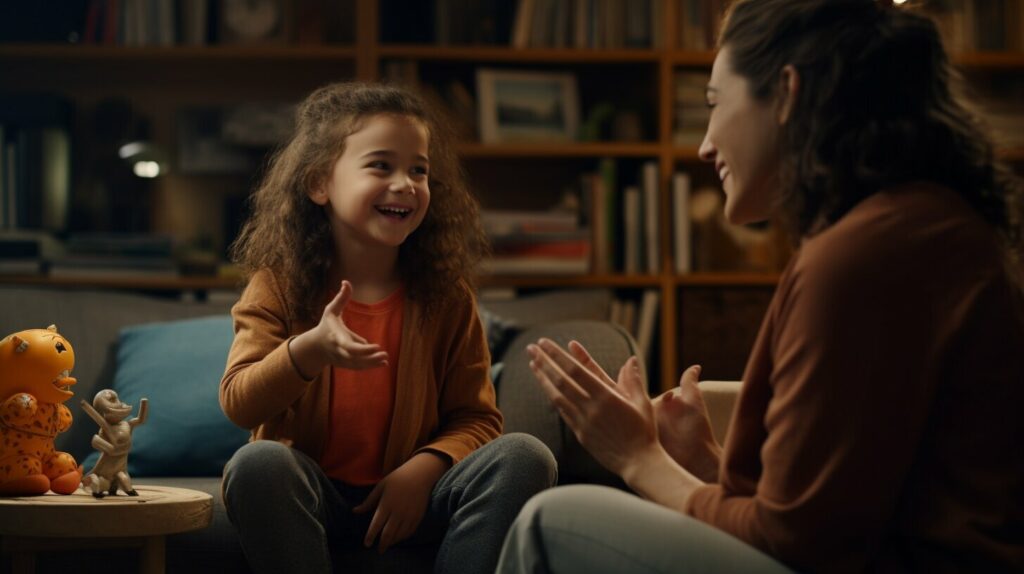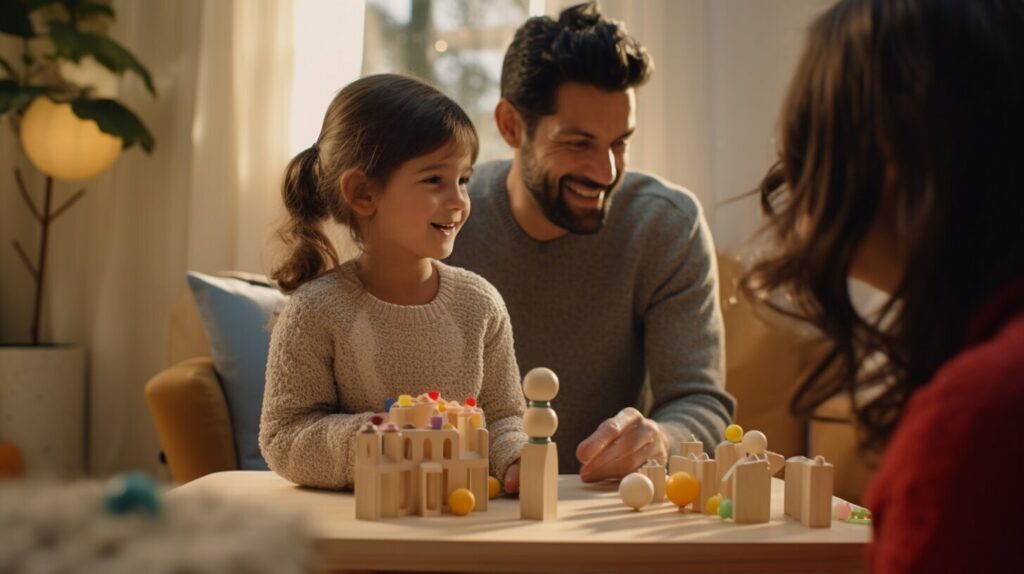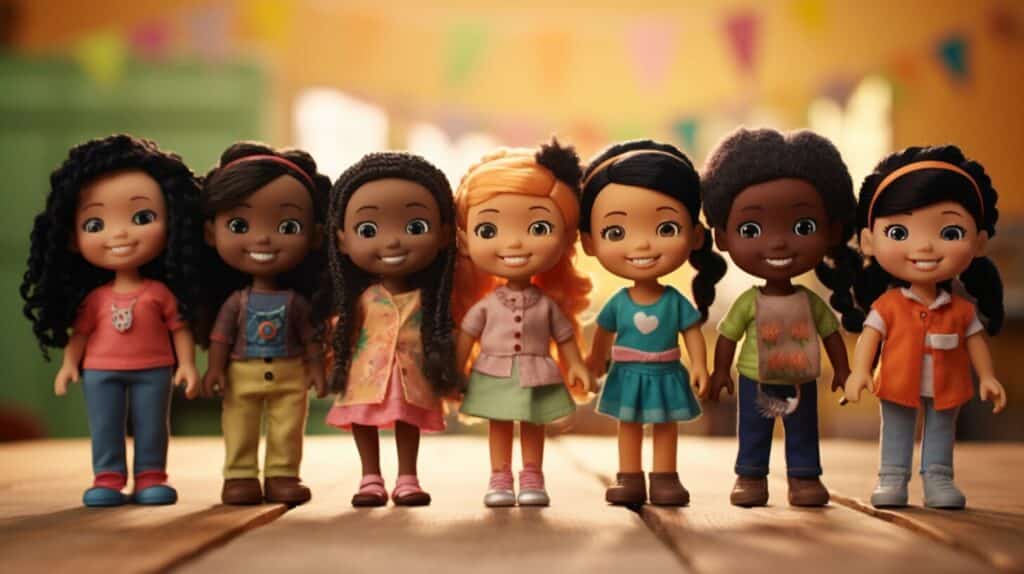As a parent or caregiver, it’s important to have open and age-appropriate conversations with children about gender. Understanding the differences between men and women is an essential aspect of growing up and navigating the world around us. By discussing gender with children, you can help promote respect, understanding, and equality.
So, how can you explain the difference between man and woman to a child? In this guide, we will provide you with practical tips and guidance on how to have these conversations in a way that is easy for kids to understand.
Key Takeaways:
- Having open and age-appropriate conversations about gender is important
- Understanding the differences between men and women is essential for navigating the world around us
- Explaining gender to kids can help promote respect, understanding, and equality
When to Start Talking About Gender
Teaching children about gender can be a sensitive topic, but it’s important to start the conversation early on. Experts suggest that as soon as children start expressing curiosity about their own or other people’s bodies, parents should begin introducing the concept of gender and explaining the basic differences between males and females.
While it’s important to start the conversation early, it’s also crucial to tailor the message to the child’s age and level of understanding. Young children can understand simple concepts such as “boys have penises and girls have vaginas,” while older children can begin to understand more complex ideas such as gender identity and societal expectations.
It’s important to note that children may ask questions at unexpected times or in public settings, so it’s helpful to be prepared with age-appropriate responses. You can use everyday situations, such as bath time or getting dressed, to start the conversation in a natural way.
Remember that your child’s understanding of gender may change and evolve over time, so it’s important to keep the conversation open and ongoing. By starting the conversation early and adapting your approach as your child grows, you can help them develop a healthy and informed understanding of gender differences.

Explaining Biological Differences
Understanding the biological differences between men and women is an essential aspect of teaching children about gender. By providing age-appropriate explanations, children can develop a better understanding of the physical disparities between males and females.
One primary difference between men and women is their reproductive system. Females have a uterus, ovaries, and fallopian tubes, which allow them to carry and give birth to children. Males, on the other hand, have testes that produce sperm for reproduction. You can use simple diagrams or visual aids to help children visualize these differences.
| Female | Male |
|---|---|
 |
 |
Another important difference is the presence of secondary sexual characteristics. For example, males tend to have broader shoulders, more body hair, and deeper voices. Females generally have wider hips, breasts, and a higher-pitched voice. You can use everyday examples, such as pointing out a man’s beard or a woman’s chest, to demonstrate these differences to children.
Emphasize that these differences are natural and normal, and that everyone deserves to be respected regardless of their physical characteristics.
You may also want to touch on the concept of chromosomes. Males have XY chromosomes, while females have XX chromosomes. Chromosomes determine many aspects of an individual’s physical and biological makeup, including their gender.
It’s important to emphasize that biological differences do not define a person’s worth or abilities. Everyone is unique, and it’s our individual qualities and characteristics that make us special.
Discussing Social and Cultural Differences
When discussing the differences between men and women with children, it’s essential to explore the social and cultural aspects of gender. Society’s expectations, gender roles, and stereotypes can shape how we understand gender, and it’s crucial to help children navigate these complexities in a positive way.
Gender Roles
One aspect of social and cultural differences is gender roles. Gender roles are the societal expectations that dictate how men and women should behave. For example, society expects men to be strong and assertive, while women are expected to be nurturing and emotional. However, these expectations put limits on individuals and can prevent them from reaching their full potential.
It’s essential to teach children that everyone should be free to pursue their interests and strengths, regardless of their gender. Encourage them to explore different activities and interests without the constraints of societal expectations.
Stereotypes
Stereotypes are assumptions or generalizations made about a group of people. For example, a common stereotype is that women are emotional and irrational, while men are logical and rational. These stereotypes can be harmful because they oversimplify individuals based on their gender and limit their potential.
Teach children to recognize and challenge stereotypes. Encourage them to question assumptions and avoid making judgments based solely on someone’s gender. Instead, emphasize treating everyone with kindness and respect, regardless of their gender.
The Importance of Diversity and Inclusion
Likewise, it’s crucial to expose children to diverse perspectives and teach them the value of inclusion. Children should learn that individuals should be respected and celebrated for who they are, regardless of their gender, race, ethnicity, religion, or any other characteristic.
As a parent or caregiver, make sure to expose children to diverse books, films, and other media that celebrate differences. Discuss the importance of diversity and inclusion and encourage children to embrace different perspectives. Doing so will help them develop empathy, compassion, and respect for all individuals, regardless of their gender or any other characteristic.

Addressing Gender Identity
Gender identity refers to the gender that individuals identify with – whether they feel like a man, woman, or somewhere in between. It is important to explain this concept to children as part of their understanding of the differences between men and women.
When discussing gender identity with children, it is crucial to approach the topic with sensitivity. Emphasize that everyone has the right to identify as the gender they feel most comfortable with and that it is important to respect and support their choices.
It can be helpful to use simple and relatable examples to explain gender identity to children. For instance, you can explain that just like how some children like the color blue while others prefer pink, some people feel more like a boy while others feel more like a girl.

It is also important to remember that children may have questions or express confusion about gender identity. It is essential to create a safe space for them to ask questions and express their thoughts freely. Use this as an opportunity to encourage thoughtful discussion and provide accurate information to help children develop a positive and inclusive understanding of gender identity.
Answering Questions and Encouraging Discussion
As you begin discussing gender with your child, it’s important to encourage questions and open dialogue. Children are naturally curious and may have inquiries that you may find uncomfortable or difficult to answer. However, it’s crucial to approach these conversations with patience and a willingness to listen to your child’s perspective.
One way to encourage discussion is by using open-ended statements. Instead of asking leading questions like, “Do you think boys should play with dolls?” try asking, “What do you think about boys playing with dolls?” This creates a safe space for your child to share their thoughts and opinions without feeling judged or pressured.

If your child asks a question you don’t know the answer to, be honest and admit that you don’t know. You can say something like, “That’s a great question! I’m not sure, but let’s look it up together.” This can be a great opportunity to teach your child valuable research skills and model good behavior by not pretending to know everything.
It’s also important to respect your child’s opinions and perspectives, even if they don’t align with your own. This will help them develop critical thinking skills and learn to respect different points of view. If your child makes a statement that concerns you, try to avoid reacting with anger or disapproval. Instead, calmly ask them why they feel that way and use it as an opportunity to start a dialogue.
By encouraging open communication, you can help your child develop a healthy and informed understanding of gender. It’s important to remember that discussing gender is an ongoing conversation that will evolve and change over time.
Emphasizing Equality and Respect
As you teach your child about the differences between men and women, it’s crucial to emphasize equality and respect. All individuals, regardless of their gender, deserve to be treated fairly and with respect.
One way to promote equality is by modeling inclusive behavior in your own interactions with others. Encourage your child to see beyond gender stereotypes and to value people based on their character and skills.
Teach your child to speak up if they see or hear someone being treated unfairly because of their gender. Encourage them to defend others’ rights and to promote acceptance and understanding of different genders.
Remember, promoting equality and respect goes beyond discussing gender differences. It’s essential to instill these values in all aspects of your child’s life, including their interactions with family, friends, and peers.

“The only way to do it is to do it together.” – Amelia Earhart
Amelia Earhart was a pioneer in aviation and fought to break down gender barriers. Her quote about the importance of working together applies to gender equality as well. By promoting equality and respect, we can work toward a more inclusive and accepting society for all genders.
Incorporating Diversity and Inclusion
Incorporating diversity and inclusion is essential when teaching children about gender differences. It’s important to promote understanding and respect for different perspectives and cultures. Here are some practical tips to help you:
- Expose your child to diverse role models of different genders, races, ethnicities, and abilities. Read books, watch movies, and attend events that showcase diversity.
- Challenge gender stereotypes by encouraging your child to pursue activities and interests outside of traditional gender roles.
- Teach your child to use inclusive language that respects people of all genders.
- Encourage your child to be an ally for gender equality and to stand up against discrimination.
Remember that children are influenced by the world around them, and it’s up to us as parents and caregivers to provide them with a positive and inclusive environment. By incorporating diversity and inclusion into our conversations about gender, we can help our children become well-rounded and empathetic individuals.

Conclusion
Congratulations! You have completed the how-to guide on explaining the difference between man and woman to a child. By now, you should have a good understanding of when and how to talk to your children about gender, including biological and social differences, gender identity, equality, diversity, and inclusion.
Remember, having open and age-appropriate conversations about gender is essential for nurturing healthy relationships and promoting respect and understanding among all genders. By following the tips and guidance provided in this guide, you can equip your children with the knowledge and skills to navigate the complex world of gender and sexuality.
Continue to encourage open conversations with your children, answer their questions with honesty and sensitivity, and promote a culture of respect and inclusivity in your home and community.
How to Explain Polyamory to a Child as Part of Teaching About Relationships?
When teaching children about relationships, it is important to address diverse forms of love. Explaining polyamory to a child can be done by emphasizing the concept of having multiple loving relationships. Honesty, age-appropriate language, and open communication are key when conveying how to explain polyamory to a child.
FAQ
Q: Why is it important to explain the difference between man and woman to a child?
A: It is essential to have open and age-appropriate conversations about gender with children to help them understand and respect the differences between males and females.
Q: When should I start talking about gender with my child?
A: It is never too early to start introducing the concept of gender to children. However, you should tailor the information to their age and understanding.
Q: How can I explain the biological differences between men and women to my child?
A: You can use simple and relatable examples to help your child grasp the physical disparities between males and females, such as differences in reproductive systems or body structures.
Q: How do social and cultural differences influence our understanding of gender?
A: Society’s expectations, gender roles, and stereotypes can shape our understanding of gender. It’s important to discuss these influences and teach children that everyone deserves respect regardless of their gender.
Q: How can I address the concept of gender identity with my child?
A: Approach the topic with sensitivity, providing age-appropriate explanations. Encourage your child to ask questions and foster a supportive environment where they can explore their own identity.
Q: How should I answer my child’s questions about gender?
A: Be open and honest, using language your child can understand. Encourage further discussion and respect different perspectives, promoting a safe space for learning.
Q: How can I teach my child about equality and respect between genders?
A: Emphasize the importance of treating everyone with fairness and respect, regardless of their gender. Encourage discussions about gender equality and challenge stereotypes.
Q: How can I incorporate diversity and inclusion when teaching my child about gender differences?
A: Expose your child to diverse perspectives and challenge stereotypes. Encourage them to appreciate and celebrate individual differences, fostering an inclusive mindset.






